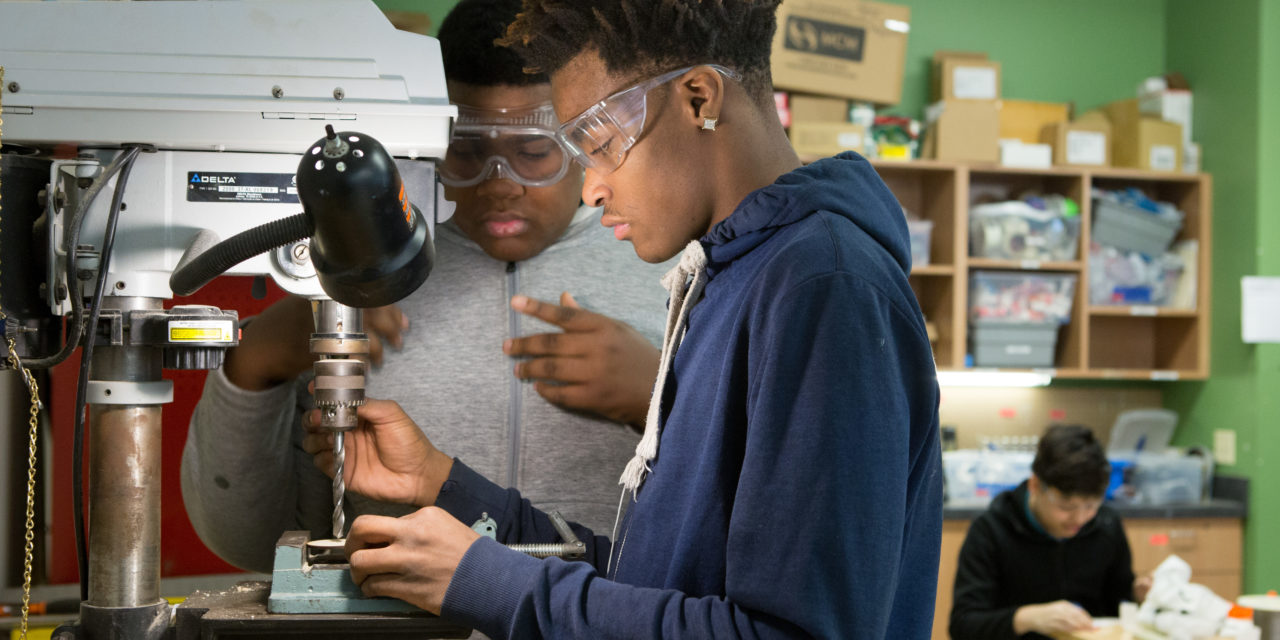“It’s going to be great,” Houston entrepreneur Jim McIngvale told a reporter about the charter school he was planning to open in August 2020. According to McIngvale, known locally as “Mattress Mack,” the new school—named Premier High School—would be located inside one of his businesses, Gallery Furniture, and offer Career and Technical Education (CTE) courses in automotive, electrical, welding, and carpentry.
While having part of a high school’s curriculum devoted to “valuable job training”—as McIngvale put it—might sound beneficial to students, some of that training is on-the-job at Gallery Furniture. McIngvale, in a pitch to prospective students, sketched out what this looks like in practice. His school is “going to train you for four days a week . . . . That’s going to be free. You work for Gallery Furniture one day a week to pay off the, ah, equipment that you might need, tuition, whatever,” he said in a program broadcast on a local morning radio show.
So when McIngvale exclaims his school is “absolutely free,” what he really means is that he’s getting one day per week of free labor in addition to free workforce training, at taxpayers’ expense, for the students who graduate and decide to stay on as Gallery Furniture employees. It’s easy to see this setup as a racket; what’s less obvious is how Premier High School challenges the idea of a liberal arts education model, which consists of a holistic learning experience where students develop their creativity and critical thinking along with technical career knowledge and skills. Instead, the sole purpose of Premier, according to a local reporter, is to “get a job, keep a job, [and] help career advancement.”
But it’s not just small entrepreneurs like McIngvale who see public schools as a potential source of cheap employee training. A 2021 New York Times Magazine article about Amazon’s influence in California included a section on career and technical education courses taught at a high school in San Bernardino. Here, students wear shirts “emblazoned with the Amazon logo” and learn in a classroom “designed to emulate the inside of an Amazon facility.” According to the article, “The lesson of the day was on Amazon’s ‘14 Leadership Principles.’ ”
A “giant sweepstakes-style Amazon check” in the classroom bears the $50,000 figure that Amazon donated to start the program—a sum that likely doesn’t even cover the costs of employing the teacher.
Aligning school curriculums to the demands of big businesses is no doubt helpful to these companies. And their efforts are bolstered by the fact that these courses are enormously popular in U.S. public schools. In 2016–2017, the most recent year for which data is available, 98 percent of school districts offered career and technical education programs at the high school level, and a 2017 study found 79 percent of high school graduates earned at least one credit in these courses.
However, career and technical education programs funded by major companies tend to narrow student learning to the needs of specific employers and can be harmful to students’ long-term employability, limiting their future opportunities.
In an April 2022 study, we looked at the increasing influence of corporations in shaping career and technical education programs in public schools. We found that when corporations gain control of school curriculums—rather than educators, parents, and elected school boards—students get locked into narrower courses of study.
This diminishment of opportunity is often sold to parents as “career pathways” to their children’s future employability. But insufficient attention has been given to the collusion among corporations and government bureaucrats to provide big companies with workforce training at taxpayers’ expense.
For our study, we interviewed families and educators from six states—Virginia, Colorado, Tennessee, Ohio, Utah, and New York—who had been in career and technical education programs that were heavily influenced by big businesses. We contacted them via online forums that ranged in size from seventy members to nearly 1,400 members.
We found that many parents are troubled by the growing tendency in these programs to force students, as early as the seventh grade, into career pathways that narrow their learning opportunities.
Miranda, a parent of four children ages twelve to eighteen, is unhappy that her school district changed its curriculum. Her youngest child, who is in middle school, now takes a class on career exploration, instead of music, art, or drama electives. Next year, in eighth grade, she’ll have to pick a career track. “Whatever [she] chooses,” Miranda told us, “that’s how the county public school is going to channel [her].” (Study subject names have been changed to ensure anonymity.)
Lilian, a parent of three children ages eleven, fourteen, and eighteen, felt it wrong that her school district organizes high schools by career tracks because, she said, “If [my] child doesn’t like one of those tracks, then they would need to go to a different high school.”
“They’re making [the curriculum] so specific,” said Nadia, a mother of two boys, “so specialized, someone would graduate high school and have spent two years learning how to be a lineman operator for the electric utility,” or, she adds, “in my county, Cisco Systems.”
Annie, a parent of two boys ages thirteen and sixteen, feared the average parent isn’t aware “how children are steered towards particular careers” and how “at a certain point, [your child is] not able to switch” once the career tracking has started.
In our study, we found numerous examples of how career and technical education programs shift resources toward hyper-specialization aligned with specific corporations, including Ford, Dominion Energy, and Amazon. These programs pop up often in states that create “talent pipelines” for certain industries, especially in the tech sector.
Federal agencies from the Department of Labor to the Department of Education provide funding and other support for states that establish boards and agencies to develop workforce plans and systems focused on employment and economic outcomes.
Nearly every state now has some sort of workforce plan that benefits from federal legislation, including the Every Student Succeeds Act, the Workforce Innovation and Opportunity Act, and the 2018 reauthorization to the Carl D. Perkins Career and Technical Education Act. These plans seek to create career pathways in K-12 and higher education that are aligned with businesses’ labor needs. In fact, a condition of the Perkins Act, a major funding source for career and technical education, is that “programs of study must align with industry.”
This support and funding from the federal government has led many states to align K-12 education programs with workforce development plans targeted to specific industries. One such effort divides Washington State into twelve regions, each with a local workforce council that ensures education plans in each region are aligned to the goals created by government bureaucrats and representatives of the business community.
The state of Virginia is divided into nine regions based on priority industry clusters in each region. A region dominated by technology, finance, and consulting services is aligned to an education program that is very different from a region dominated by agriculture, mining, and manufacturing.
Businesses work their way into schools by donating money and resources to education programs. Oil and gas companies, for example, give pro-petroleum curriculums to schools. Defense contractors sponsor school math contests and robotics competitions. Dominion Energy and Amazon contract with districts to provide curriculum, technology, and instructional services.
Amazon has multiple entry points into a school district, all of which bring significant benefits to the corporation. The company, through its Amazon Web Services enterprise, can partner with K-12 schools to provide free cloud computing training to students using its proprietary software—and thus, in effect, get free training for its future workforce. Also, states and school districts can contract with Amazon Web Services to store institutional data, including students’ personal information.
Meanwhile, it’s unclear whether students benefit from these arrangements. The idea of linking employer demands for qualified employees directly with education is not new, and some studies have found that career and technical education can enable early employment, but there’s a general lack of empirical evidence for the effectiveness of this instruction long term.
When a student is trained to work at Cisco Systems or Amazon Web Services, they learn what’s necessary to perform a function. But they acquire neither depth nor breadth of knowledge in computer science, theory, physics, philosophy, or ethics—subjects also associated with engineering and computer science.
“I want my child to have a very well-rounded education that will serve him for the rest of his life,” Nadia told us. “I want my child to explore and experience lots of things, so he can decide for himself what it is that he wants to do with his life.”
So should every child.
Velislava Hillman is a visiting fellow at the London School of Economics where she researches how children use digital technology in formal and informal learning environments. She is also a founder and partner of Education Data | Digital Sovereignty (EDDS), a social enterprise that aims to empower and protect children’s data. Follow her on Twitter @Velislava777.
(Photo by Allison Shelley/The Verbatim Agency for EDUimages, CC BY-NC 4.0.)






Recent Comments